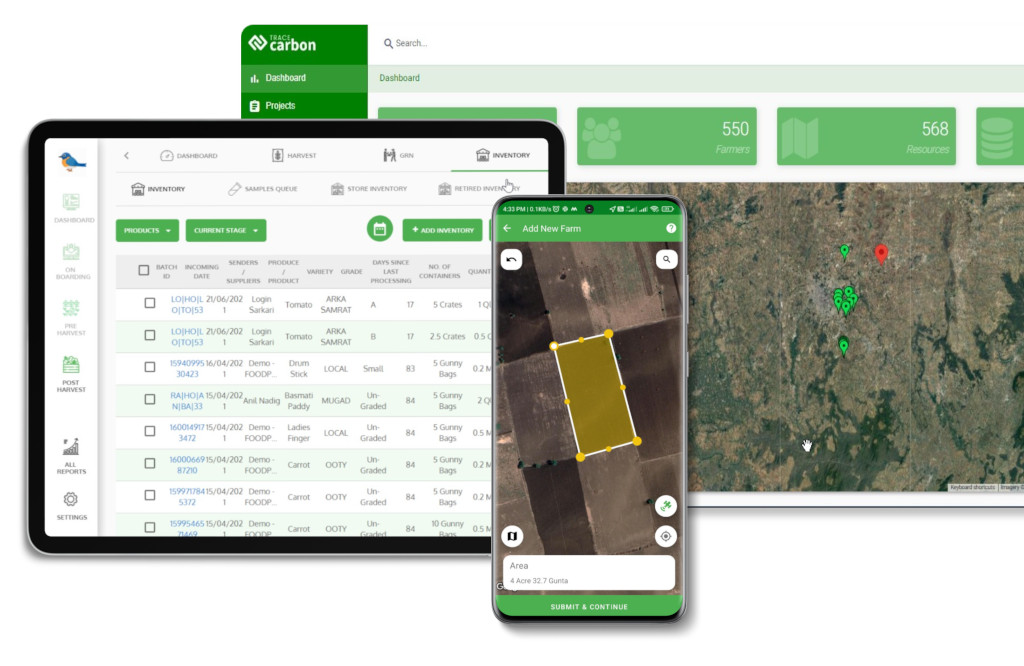Contact: +91 99725 24322 |
Menu
Menu
Quick summary: Discover how digital traceability simplifies EUDR compliance by automating supplier onboarding, GPS-based mapping, and Due Diligence Statement (DDS) generation. Learn how to achieve deforestation-free, legally sourced supply chains with ease.

Digital traceability for EUDR compliance involves using technology to track and verify supply chain data from farm geolocation to legal documentation, to ensure products are deforestation-free and legally sourced. It enables the automatic generation of Due Diligence Statements (DDS) and real-time monitoring of sustainability risks, streamlining audit readiness. This approach is essential for meeting the EU’s regulatory requirements for supply chain transparency and legality.
Starting December 2025, companies dealing in regulated commodities like cocoa, coffee, palm oil, and rubber must prove that their supply chains are deforestation-free, legally sourced, and backed by a verified Due Diligence Statement (DDS). If you can’t, your shipments to the EU could be delayed, rejected, or fined. Most agribusinesses still rely on fragmented spreadsheets, siloed supplier data, and manual compliance checks. These systems aren’t built to handle the volume, velocity, or verification depth required by the EU Deforestation Regulation.
So how do you scale compliance, without scaling complexity? This blog breaks down how digital traceability directly addresses all three core EUDR obligations:
Whether you’re an operator, trader, exporter, or sustainability lead, this post will help you understand how a tech-first approach can move you from exposure to assurance fast.
Key Takeaways
Digital traceability is essential for meeting EUDR requirements by offering real-time visibility, GPS-verified geolocation, and automated Due Diligence Statement (DDS) generation. Unlike basic tracking tools or spreadsheets, digital traceability platforms help operators and traders prove deforestation-free sourcing, validate land legality, and stay audit-ready with EU-compliant documentation. Platforms like TraceX simplify supplier onboarding, automate risk scoring based on benchmark country logic, and streamline compliance across complex, multi-tier supply chains.
Digital traceability, in the context of the EU Deforestation Regulation (EUDR), refers to the technology-enabled ability to trace a product’s journey from its origin, such as a farm or forest plot, all the way to the EU entry point, with geo-verified, legally compliant, and time-stamped data.
For exporters, traders, and processors, digital traceability means capturing and verifying location, ownership, and legality data at every step of the supply chain—using digital tools like mobile apps, satellite overlays, and automated document systems—to generate a complete Due Diligence Statement (DDS) for EUDR compliance.

Unlike legacy ERP systems or paper records that track only inventory or logistics, digital traceability under EUDR requires:
In short, it’s compliance-first traceability, not just operational tracking.
This kind of digital traceability isn’t just a nice-to-have it’s mission-critical for companies navigating the new regulatory landscape of global sourcing.
The EU Deforestation Regulation (EUDR) requires businesses to meet three key obligations: ensure deforestation-free sourcing, prove legal land and labor use, and submit a Due Diligence Statement (DDS) before products enter the EU market. Digital traceability enables companies to meet these demands at scale, with speed and accuracy something manual systems cannot deliver.
To comply with EUDR, companies must prove that products are not linked to deforestation after December 31, 2020. Digital traceability platforms integrate:
This geospatial evidence is legally defensible and instantly verifiable ensuring your sourcing meets the EU’s zero-deforestation threshold.
Under EUDR, operators must also prove the legal production of commodities, including land ownership/tenure and labor rights. Digital traceability platforms help:
This eliminates missing paperwork and reduces the risk of rejection due to unverifiable or outdated records.
The DDS is the final checkpoint for EUDR compliance it consolidates data on deforestation status, legality, risk, and geolocation. Digital traceability systems:
Without digital traceability, building this level of detail manually across multi-tiered suppliers would be resource-intensive, error-prone, and nearly impossible at scale.
In summary, digital traceability transforms EUDR from a compliance burden into a data-driven opportunity, empowering companies to protect markets, enhance transparency, and build resilience into their sourcing operations.
Explore our in-depth blogs to understand the latest on:
EUDR Compliance Essentials – What every operator and trader must know
Step-by-Step Guide to EUDR Due Diligence – How to collect, validate, and submit supplier data
The EU Deforestation Regulation (EUDR) lays out strict, non-negotiable requirements for any operator or trader importing regulated commodities (like coffee, cocoa, soy, palm oil, timber, etc.) into the EU. These aren’t just broad sustainability goals, they are precisely defined, enforceable criteria. Here’s a breakdown of the top regulatory demands and how digital traceability platforms streamline each step.

What the regulation requires:
All production plots must be geolocated with polygon coordinates if they are 0.5 hectares or larger. This geolocation data must prove that the plot has not been deforested after the 31 December 2020 cut-off date.
How digital tools help:
What the regulation requires:
Operators must show that land use and labor conditions are legal according to national laws. This includes land titles, lease agreements, labor rights documents, and community consent records.

How digital tools help:
Okay — you’ve mapped your farmers. You’ve captured their GPS plots. You’ve digitized declarations and land history. Now comes the part where many traceability systems quietly break down: keeping the chain intact from farm… to port.
Because if your sourcing story starts strong but falls apart during aggregation, you don’t really have traceability; you have a trust gap. That’s why this step is so crucial: connecting the dots between what’s grown, what’s moved, and what gets exported, all the way back to the individual farmer or plot.
Under EUDR and most major certification schemes, it’s not enough to show who your farmers are.
You need to prove that the coffee, cocoa, or rubber in that specific shipment came from those mapped, verified plots.
That means:

What the regulation requires:
A Due Diligence Statement (DDS) must be submitted for each shipment before it enters the EU market. It must confirm compliance on deforestation-free status, legality, and traceability, with zero risk or evidence of mitigation.
How digital tools help:
Digital traceability platforms remove the guesswork, manual burden, and risk of non-compliance, while making it faster to secure and maintain market access in the EU. Instead of juggling spreadsheets and fragmented files, operators gain a centralized, audit-ready system tailored to EUDR.
As the EU Deforestation Regulation (EUDR) moves from policy to enforcement, the margin for error in supply chain data and due diligence is rapidly shrinking. Businesses can no longer rely on spreadsheets or siloed ERPs to manage compliance. You need a digital platform specifically built to handle the technical, spatial, and regulatory demands of EUDR.
EUDR requires plot-level geolocation for every land parcel where commodities are grown. This means not just GPS points, but multi-point polygons that outline plot boundaries, especially if they’re 0.5 hectares or more.
Platform feature to look for:
This ensures the location data you submit is audit-proof and regulation-aligned.
Proving legal land use and labor compliance is a core EUDR obligation. But collecting, validating, and tracking dozens (or thousands) of land deeds, labor documents, and community consent records manually is impractical.
Platform feature to look for:
This reduces the compliance burden while boosting accuracy and audit readiness.
Before any product enters the EU, the operator must submit a Due Diligence Statement (DDS) in a specific structured data format. The DDS must include geolocation, legality, and risk mitigation details, and be error-free.
Platform feature to look for:
This saves time and ensures you submit a fully compliant DDS for every shipment, avoiding costly rejections or penalties.
EUDR compliance doesn’t exist in isolation, it needs to work with your existing systems, such as procurement, sourcing, and logistics platforms.
Platform feature to look for:
These integrations eliminate duplication, reduce manual entry, and ensure a single source of truth for both compliance and operations.
A true digital traceability platform for EUDR isn’t just a document repository, it’s an intelligence layer that collects, verifies, and reports supply chain data in line with regulation. By prioritizing these four core capabilities, businesses can reduce compliance risk, boost operational efficiency, and confidently access the EU market.
Here’s how TraceX’s EUDR Compliance Platform enables real-time traceability and effortless EUDR alignment
Most operators struggle with onboarding smallholder farmers and co-ops due to language barriers, connectivity issues, and lack of structured data.
How TraceX helps:
Result: Over 90% onboarding coverage in fragmented, hard-to-reach networks.
EUDR requires that every supplier and plot be risk-classified based on geography, data completeness, and deforestation exposure. Manual scoring is impractical.
How TraceX helps:
Result: A dynamic supplier risk matrix that helps compliance teams prioritize due diligence actions.
EUDR compliance requires cross-functional coordination across sourcing, legal, sustainability, and trade teams. Without role-specific tools, collaboration breaks down.
How TraceX helps:
Result: End-to-end visibility, accountability, and readiness across the organization.
EUDR compliance may feel like a regulatory burden, but for forward-thinking agri-exporters, processors, and sustainability teams, it’s a real opportunity. By building traceability from the ground up and digitizing every step of your sourcing journey, you’re not just avoiding penalties, you’re unlocking premium markets, building buyer trust, and future-proofing your supply chain.
The right digital platform makes this transformation faster, smarter, and scalable, even across smallholder networks or remote geographies.
Start small, move fast, and stay ahead of the curve.
Because in 2025 and beyond, traceability won’t be optional. It’ll be your license to trade.
Digital traceability platforms enable companies to map supplier farms with GPS polygons, verify land legality and labor conditions, and auto-generate EU-compliant DDS—reducing manual errors and audit risk.
Yes. EUDR mandates plot-level geolocation, typically captured as GPS polygons, for every land parcel where regulated commodities are produced, especially for plots ≥0.5 hectares.
Absolutely. Modern traceability platforms automate document collection, risk scoring, and DDS submission, replacing time-consuming manual workflows with scalable, audit-ready systems.
Get clarity on what the regulation really demands, and how to get your systems audit-ready.
EUDR Geolocation Requirements Explained
